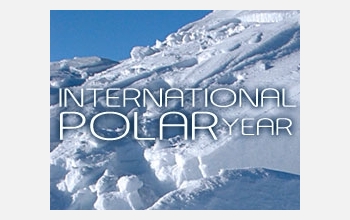Fact Sheet
NSF and the International Polar Year 2007-2008
February 5, 2007
This material is available primarily for archival purposes. Telephone numbers or other contact information may be out of date; please see current contact information at media contacts.
Beginning in March 2007, the United States will lead more than 60 nations in deploying thousands of researchers in a global research campaign to improve our understanding of the role of the polar regions in the global ecosystem. This initiative is called the International Polar Year (IPY) 2007-2008.
IPY will extend through March 2009, to allow researchers to conduct two annual observing cycles in each polar region, particularly in the isolated areas that are prohibitively cold and dark for roughly six months a year.
IPY Establishment and Leadership
The International Council for Science, in conjunction with the World Meteorological Organization, formally established IPY 2007-2008 to mark the 125th anniversary of the first polar year. The Polar Research Board of the National Academy of Sciences set the research and education goals for U.S. participation in IPY in the report, A Vision for the International Polar Year 2007-2008.
Some of the U.S. efforts as outlined by the U.S. National Committee for IPY include:
- Use IPY to initiate a sustained effort to assess large-scale environmental change and variability in the polar regions.
- Pioneer new polar studies of coupled human-natural systems that are critical to U.S. societal, economic, and strategic interests.
- Explore new scientific frontiers from the molecular to the planetary scale.
- Use IPY as an opportunity to design and implement multidisciplinary polar observing networks for long-term study.
- Invest in critical physical and human infrastructure and technology to guarantee IPY leaves enduring benefits.
- Excite and engage the public to increase understanding of the importance of the polar regions in the global system and advance general science literacy.
- Allow U.S. scientists to become leaders in IPY research.
The White House Office of Science and Technology Policy has named the National Science Foundation (NSF), which manages the U.S. Antarctic Program and chairs the Interagency Arctic Research Policy Committee, the lead federal agency for coordinating U.S. IPY activities. All federal agencies engaged in scientific research and education--including the Department of Interior, the National Oceanic and Atmospheric Administration, NASA, the National Institutes of Health and others--will participate in IPY.
In FY 2007, NSF proposes to spend more than $60 million on IPY science, engineering and education. NSF's FY 2008 budget request includes nearly $59 million for IPY activities.
IPY Research and Education
During IPY, U.S. researchers will investigate and refine our knowledge of the role of the polar ice sheets as regulators of global climate and repositories of climate history, probe the depths of the Arctic Ocean to better understand its role in ocean circulation and map a landscape that is less known than the surface of the moon. They also will study microscopic life in such unlikely places as the ultra-saline and frigid lakes of Antarctica's McMurdo Dry Valleys to discover the extreme tolerances of life in such unearthly places.
IPY projects will include Alaska and other Native peoples as active participants in setting the research agenda.
Many research projects will include education components to help build a legacy of scientific literacy. NSF will make separate grants to educators to teach children in the classroom about the importance of the polar regions as well as to inform the general public through science-related television programs, films, radio programs, museum exhibits and other media.
Members of the public and the news media can follow IPY field research, discover educational opportunities and find classroom resources at www.us-ipy.gov, an interagency IPY Web site managed by NSF.
Amundsen-Scott Research Station
The most recent Polar Year--the 1957 International Geophysical Year (IGY)--laid the foundations for U.S. leadership in polar science and the nation's role as a guarantor of the integrity of the Antarctic Treaty System, which sets Antarctica aside solely for scientific purposes.
A U.S. IGY milestone in 1957 included building the first manned station at the South Pole. NSF expects to dedicate a completely rebuilt and ultra-modern U.S. research station at the South Pole during the IPY period.
-NSF-
Media Contacts
Peter West, NSF, (703) 292-7761, email: pwest@nsf.gov
The U.S. National Science Foundation propels the nation forward by advancing fundamental research in all fields of science and engineering. NSF supports research and people by providing facilities, instruments and funding to support their ingenuity and sustain the U.S. as a global leader in research and innovation. With a fiscal year 2023 budget of $9.5 billion, NSF funds reach all 50 states through grants to nearly 2,000 colleges, universities and institutions. Each year, NSF receives more than 40,000 competitive proposals and makes about 11,000 new awards. Those awards include support for cooperative research with industry, Arctic and Antarctic research and operations, and U.S. participation in international scientific efforts.
Connect with us online
NSF website: nsf.gov
NSF News: nsf.gov/news
For News Media: nsf.gov/news/newsroom
Statistics: nsf.gov/statistics/
Awards database: nsf.gov/awardsearch/
Follow us on social
Twitter: twitter.com/NSF
Facebook: facebook.com/US.NSF
Instagram: instagram.com/nsfgov



